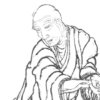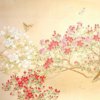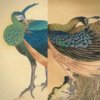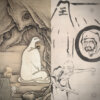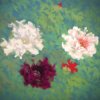Mochizuki Unsō: A Disciple of Tsubaki Chinzan in Enshū Region and an Expert of Bird-and-Flower Painting.
Mokuren Botan (Magnolia and Peonies)
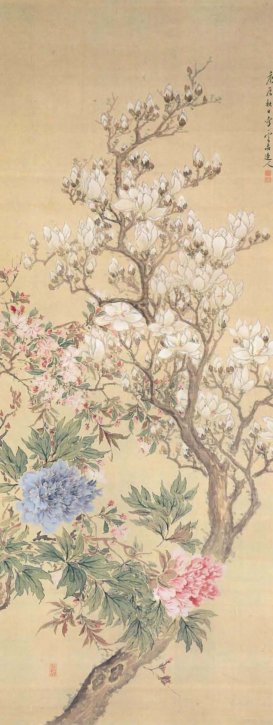
Mochizuki Unsō was born in Edo in 1832. He was a disciple of Tsubaki Chinzan and senior to Watanabe Shōka and Tsubaki Kakoku (the eldest son of Tsubaki Chinzan). He was one of the painters who experienced the turbulent times of the early Meiji period. Chinzan was born into a samurai family, so he only took disciples from the samurai class. Unsō was a former shogunate retainer, so he was allowed to study under Chinzan, and his natural talent for coloring was admired by Chinzan. It is said that when Chinzan was busy, he asked Unsō to teach his disciples (more than 30), including Watanabe Shōka and Tsubaki Kakoku.
The painting of magnolia, a hall crabapple and peony is called “Gyokudō-Fuki-Zu (a painting of wealth and fame)” and the painting combines all three, with a large white flowering magnolia at the top and white-red, and purple peonies swaying in the wind at the bottom. Peony was a specialty of the artists in the Kazan Watanabe and Tsubaki Chinzan families, and this painting is no exception. The mokkotsu technique, which he probably learned from Chinzan, is particularly effective on peony flowers and leaves. The beauty of the coloring is also fully demonstrated in the peonies and the red-tinted hall crabapples. The reason why there are so few remaining works by Unsō, who excelled in paintings of flowers and birds, may be that he suffered a hard time in his life as a samurai and a painter before and after the Meiji Restoration. In each of his works, there are faint traces of his study of Tsubaki Chinzan. Unsō died in Tokyo in 1896.
- Mokkotsu: A technique where the object is expressed by the shading of sumi ink or color rather than by using outlines (koppō.) It is widely known as a technique for kachō-ga (paintings of flowers and birds).
Naten Suisen (Nandina Domestica and Daffodil)
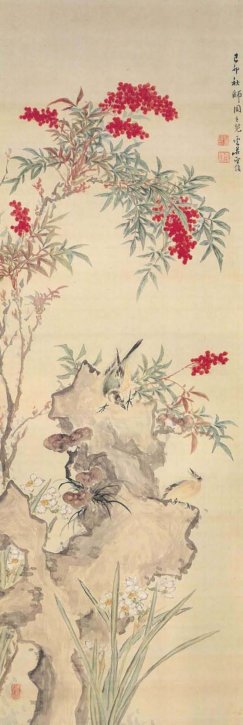
This work was created in the autumn of 1888 and depicts nandina domestica with abundant clusters of round red berries covering the upper part of the painting. Two small birds with whiteheads are chirping on the rocks, which looks like Taihu stones or dead trees, creating a lively atmosphere. The red of the nandina domestica is so vivid that it catches the viewer’s eye.
The painting also depicts reddish-brown Reishi mushrooms and white-flowered daffodils around the rocks. The painting gives us a harmonious and gentle feeling like when we see the artwork of Tsubaki Chinzan, probably because it is mainly created on the mokkotsu technique. A method of applying a ground or primer on a screen has been passed down from Unsō to Yamashita Seijō. From the Meiji 10s to the 20s, Nanga painting was at its peak. Unsō left Tokyo under these circumstances and became an outstanding painter who supported the rise of Nanga in the provinces. Much about Unsō’s life remained unclear, and it is only recently that his year of birth and death have been discovered.

